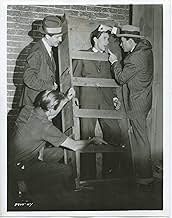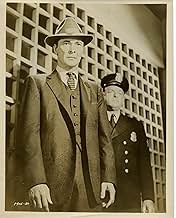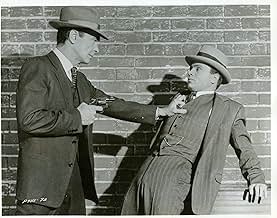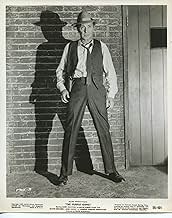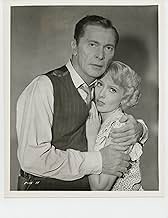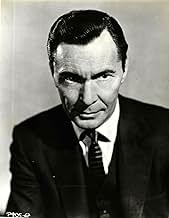La historia de la infame Purple Gang, una banda de contrabandistas, secuestradores y asesinos en Detroit en la década de 1920.La historia de la infame Purple Gang, una banda de contrabandistas, secuestradores y asesinos en Detroit en la década de 1920.La historia de la infame Purple Gang, una banda de contrabandistas, secuestradores y asesinos en Detroit en la década de 1920.
- Dirección
- Guionista
- Elenco
Suzanne Ridgway
- Daisy
- (as Suzy Marquette)
Joe Turkel
- Eddie Olsen
- (as Joseph Turkel)
James Roosevelt
- Self in Prologue
- (as Congressman James Roosevelt)
Benjie Bancroft
- Police Officer
- (sin créditos)
- Dirección
- Guionista
- Todo el elenco y el equipo
- Producción, taquilla y más en IMDbPro
Opiniones destacadas
Low budget "exposee" style film paints a somewhat accurate picture of Detroit's Purple Gang from the 20s. Worth seeing for Robert Blake's performance, which transcends the movie.
Cheapo production. This is supposed to be the 1920s, but there is no attempt to use costumes or hair styles of that era. The men all wear 1950s hats. Robert Blake plays tough as the juvenile gang leader. Barry Sullivan walks through his part as the detective as though he wanted to be somewhere else. His wife,of course, wants him to quit. The gang looks like a Central Casting call for B-list juveniles. As clean and nice looking a bunch of hoodlums as can be imagined. If they could dance they would be ready for West Side Story. The sets are unadorned and look like they were assembled in somebody's garage. There is a lot of unconvincing gunplay and actors falling to the floor, but no blood.
"The Purple Gang" is a film that is enjoyable to watch--much like an episode of "The Untouchables". However, like that television show, it's not much of a history lesson and the actions of the real Purple Gang in Detroit were very, very different than what you see in the film. In fact, you'd hardly recognize much of the gang in this one.
In real life, the Purple Gang was a tough organization in Detroit consisting mostly of Jewish gangsters. The gang was run by several brothers as well. And, the end of the gang was nothing like in the film. Yet, in the film they are run by one guy alone (Robert Blake) and the actors all seem like typical antisocial Gentiles.
So why, despite being mostly wrong, do I score this one a 6? Well, it's exciting and as long as you accept that it's mostly fiction, you'll have a nice time watching the film. It never is dull!
In real life, the Purple Gang was a tough organization in Detroit consisting mostly of Jewish gangsters. The gang was run by several brothers as well. And, the end of the gang was nothing like in the film. Yet, in the film they are run by one guy alone (Robert Blake) and the actors all seem like typical antisocial Gentiles.
So why, despite being mostly wrong, do I score this one a 6? Well, it's exciting and as long as you accept that it's mostly fiction, you'll have a nice time watching the film. It never is dull!
Policeman Barry Sullivan fights Detroit's Purple Gang led by Robert Blake in the 1920s and 1930s in this Allied Artists programmer directed by Frank MacDonald. Quite obviously shot on studio lots and underdecorated sets, with a lot of stock footage edited into montages, it also features a high-speed narrative voice-over narrative by Sullivan.
The Purple Gang was a real Detroit mob, perhaps best remembered for being predominantly Jewish. The movie makes no indication of this.
Suzanne Ridgeway has a small part in this movie. She had entered the movies in 1937. Ultimately, she appeared in 233 feature films, 12 shorts and 13 television appearances. In that time, she was received on-screen credit four times, including the infamous FROM HELL IT CAME. This was her last movie appearance. She died in 1996, 78 years old, another of the forgotten horde of players whose presence helped make two Oscar winners and a multitude of other movies.
The Purple Gang was a real Detroit mob, perhaps best remembered for being predominantly Jewish. The movie makes no indication of this.
Suzanne Ridgeway has a small part in this movie. She had entered the movies in 1937. Ultimately, she appeared in 233 feature films, 12 shorts and 13 television appearances. In that time, she was received on-screen credit four times, including the infamous FROM HELL IT CAME. This was her last movie appearance. She died in 1996, 78 years old, another of the forgotten horde of players whose presence helped make two Oscar winners and a multitude of other movies.
Most of my 7/10 goes to two things - Robert Blake's effective portrayal of completely amoral, calculating, and mentally unbalanced baby-faced mobster Honeyboy Willard and to the rather detached documentary feel of this film as it is narrated by the cop that has vowed to put the Purple Gang away, Barry Sullivan as Lt. William P. Harley of the Detroit Police. It really has the look and feel of "The Untouchables" except with poverty row roots.
There really was a Purple Gang in Detroit in the 20's and 30's, although the character of Honeyboy is a fictional one - the actual power in the real gang was in the hands of four Jewish brothers. The cleaner and dyers war was a real one, except in real life the Purple Gang was allied with the union against non-union independents. There was no rather clean ending to the story of the Purples in real life. Like so many other gangs, Prohibition gave them money and power they could have only dreamed about, and its end sent them on a slow decline with the primary source of their wealth literally dried up.
This film is unusual in that there are no female leads or even substantial female supporting roles here. Women are just the subjects of particularly savage crimes by the Purples, and very little more, meant to underscore the violence of the Purple Gang.
If this film had been in wider release by a bigger studio, maybe Robert Blake wouldn't have had to wait until 1967 and "In Cold Blood" to catapult to stardom. Here he steals the show, kills everyone else, and gives a truly riveting performance of a guy who really loves his work for reasons that seem to have more to do with a need for power and a desire to be feared than just pure greed. Don't believe the low rating on this one - give it a try realizing it is a B feature from a small studio made just as the production code was losing its grip.
There really was a Purple Gang in Detroit in the 20's and 30's, although the character of Honeyboy is a fictional one - the actual power in the real gang was in the hands of four Jewish brothers. The cleaner and dyers war was a real one, except in real life the Purple Gang was allied with the union against non-union independents. There was no rather clean ending to the story of the Purples in real life. Like so many other gangs, Prohibition gave them money and power they could have only dreamed about, and its end sent them on a slow decline with the primary source of their wealth literally dried up.
This film is unusual in that there are no female leads or even substantial female supporting roles here. Women are just the subjects of particularly savage crimes by the Purples, and very little more, meant to underscore the violence of the Purple Gang.
If this film had been in wider release by a bigger studio, maybe Robert Blake wouldn't have had to wait until 1967 and "In Cold Blood" to catapult to stardom. Here he steals the show, kills everyone else, and gives a truly riveting performance of a guy who really loves his work for reasons that seem to have more to do with a need for power and a desire to be feared than just pure greed. Don't believe the low rating on this one - give it a try realizing it is a B feature from a small studio made just as the production code was losing its grip.
¿Sabías que…?
- TriviaThe real Purple Gang was made up of mostly Jewish members. The script of this film gave the members non-Jewish names. It was the dominate criminal organization in Detroit from about 1927 until 1932 when the gang self-destructed - with help from the Italian mob.
- Citas
William Joseph 'Honeyboy' Willard: [instructing some henchmen before setting up a deal] No liquor, no junk and no broads when I'm runnin' the show.
- Créditos curiosos[Prologue] This picture is based on information from official files which revealed the shocking story of the wave of juvenile delinquency which spawned Detroit's Purple Gang. Incredible as it may seem, this youthful rat-pack of terrorists dominated the city's underworld for more than a decade during the prohibition era.
Selecciones populares
Inicia sesión para calificar y agrega a la lista de videos para obtener recomendaciones personalizadas
Detalles
- Tiempo de ejecución1 hora 25 minutos
- Color
- Relación de aspecto
- 1.85 : 1
Contribuir a esta página
Sugiere una edición o agrega el contenido que falta

Principales brechas de datos
By what name was The Purple Gang (1959) officially released in India in English?
Responda


